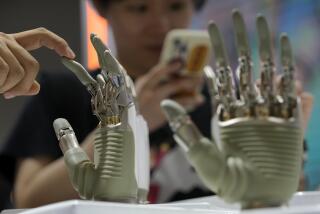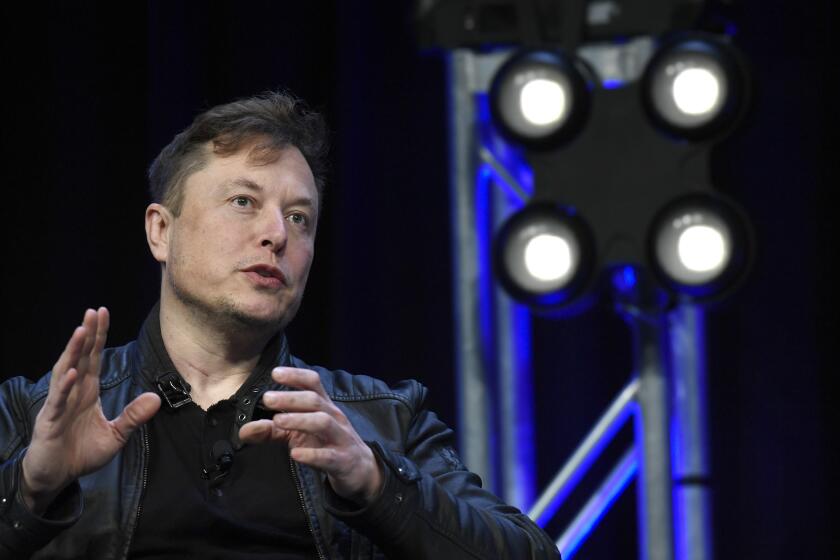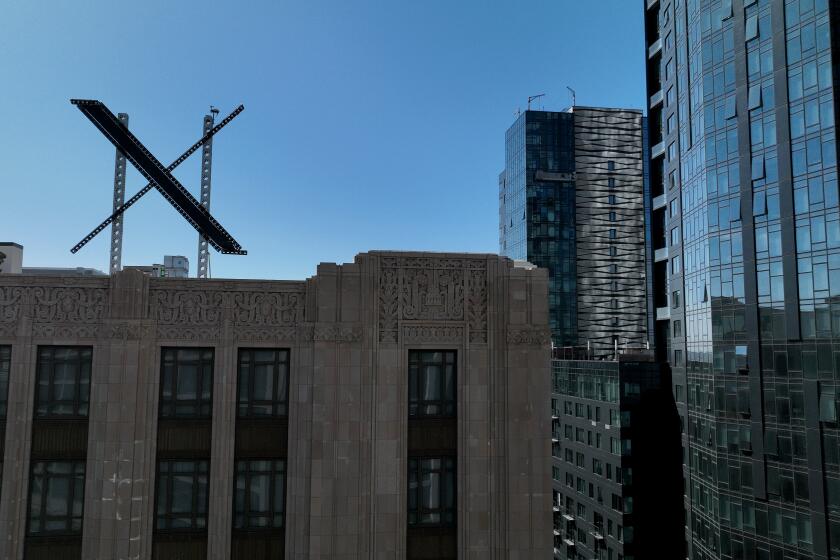New test for an old idea: actually making things
ALBANY, N.Y. — If there’s hope for 51-year-old Brett Miller, then you could say there’s hope for the American dream.
When Miller was a boy, upstate New York and the Hudson River Valley embodied the industrial might of the nation and the broad-based prosperity that made middle-class families such as Miller’s the envy of the world.
For 40 years, his father earned a good living from the sprawling General Electric Co. complex in Schenectady that built steam turbines for the nation’s electric power companies and nuclear engines for its submarines. When he retired, he had a comfortable pension.
No such dependable future awaited the younger Miller. A wave of corporate downsizing in 2009 abruptly ended his career in marketing, and he’s been unemployed ever since.
“I’m starting over,” Miller said.
What gives Miller hope -- and what could point the way for economic revitalization elsewhere in the United States -- is an effort here to test an idea that many gave up on years ago: making things.
For several decades, prominent economists and business leaders argued that so long as Americans came up with the ideas for great new products, it didn’t matter where the products were manufactured.
Today there is a growing sense that the nation’s lack of production capability is an Achilles’ heel. In this view, the country must regenerate its manufacturing base -- not necessarily producing the same things it made in bygone years, but churning out high-value goods that can compete on price and quality in today’s global marketplace.
Already, manufacturing has played an unexpectedly strong role in a recovery from the recession. Signs of renewal can be seen in many parts of the country.
In Detroit and Cleveland, the long-moribund auto industry is showing surprising strength. In Boston and Chicago, metal fabrication shops are busy again. And in the Bay Area and Austin, Texas, high-tech manufacturing is on the upswing.
The effort in the Hudson Valley represents something new: an unusual partnership between government and private enterprise. And because it is no mere government bailout of a flagging industry and focuses on high-tech, future-oriented products, this initiative has potentially greater staying power.
If it succeeds, what’s happening in upstate New York could help the whole country meet one of its most difficult challenges: re-creating the kinds of secure, long-term middle-class jobs that have long been the foundation of American prosperity.
Unless such a revitalization takes place, most economists agree, millions of people will face a more volatile and less prosperous future. And as consumers’ ability to spend erodes, so will the prospects for corporate America.
It also will be extremely difficult for the country to deal with government deficits and the soaring cost of such fundamental programs as Social Security and Medicare.
The origins of the problem are well-known: The decline of once-mighty industries, the offshoring of production and jobs, stagnating incomes and other long-term trends -- many of them aggravated by the Great Recession -- have hollowed out the middle class and left many Americans vulnerable today and anxious about tomorrow.
It used to be that almost anyone willing to work hard could get ahead. Now, that doesn’t seem so certain.
“The social contract was ripped in pieces, rendered ineffective by unforeseen forces such as globalization,” said former Michigan Gov. Jennifer Granholm, who teaches at UC Berkeley’s law and public policy schools.
“It needs to be rewritten for the 21st century.”
The catalyst for change in Albany is an unlikely physics-professor-turned-empire-builder named Alain Kaloyeros, who heads the College of Nanoscale Science and Engineering at the University at Albany.
Kaloyeros, 55, is not your ordinary public servant. He drives a black Ferrari F430 Spider, quotes “Forest Gump” and wears bleached jeans with holes in them. Yet the state pays him a salary four times the size of the governor’s because Kaloyeros has done more than build his obscure college into a powerhouse for research with applications for electronics, medicine and other industries.
He has also made the school, part of the State University of New York, a magnet for forward-looking industries in across the region.
About 250 companies, including such major high-tech firms as IBM Corp., Samsung Electronics Co. and Applied Materials Inc., have provided $6 billion to the school for equipment, labs, clean rooms and other resources.
Kaloyeros has persuaded New York state to kick in nearly $1 billion more.
At the same time, the promise of what the research center can contribute to developing fresh products and technologies is attracting new manufacturing plants. Next year, Silicon Valley chip maker Advanced Micro Devices Inc. will open a $4.6-billion semiconductor factory in Luther Forest, about 20 miles north of Albany.
The two-story facility, with a clean room the size of six football fields, is the first major chip plant built in the country in a decade.
The U.S. share of global chip-production capacity, practically 100% in the 1970s, has been sliding for years -- down to just 14% in 2009. The domestic industry’s workforce has shrunk 45% in the last decade.
The Albany plant is expected to employ about 1,400 workers, many of them $40,000-a-year technicians and equipment operators.
AMD represents the biggest payoff yet for an effort Kaloyeros started some 15 years ago.
Early on in his career in Albany, Kaloyeros zeroed in on the burgeoning field of nanotechnology, the science of manipulating materials at a microscopic level. Nanotechnology is at the heart of computer chips and scores of other high-tech applications.
Sheldon Silver, the Democratic speaker of the state Assembly, recalled Kaloyeros knocking on his door 15 years ago asking for several million dollars to build a dust-free room to test electronic equipment.
“That started the whole thing,” Silver said.
There are major nanotech centers in Belgium, France and Japan, but Albany has pushed hard to be in the vanguard.
In about a decade, the college has grown from 70 researchers and staff working inside a single building to 2,600 employees spread out across a sprawling campus.
Its engineers operate $60-million lithography tools, and rival companies are working together on research projects in a way that was once unthinkable.
A few years ago, Kaloyeros flew to Japan and, over a meal of shabu-shabu, cut a deal with Tokyo Electron Ltd.’s chief. Now the semiconductor equipment maker runs a lab in the school next to its archrival, Applied Materials.
Kaloyeros also persuaded Sematech, a consortium of global chip firms, to relocate to Albany from Austin, Texas.
He has lured top industry players from Silicon Valley as well, typically negotiating with them at the local Starbucks.
Willy Shih, a Harvard Business School professor who has researched comparative industrial policies, views the new AMD chip plant as “a great step.” And he praises the work at the nanotech center.
But Shih said it’s not nearly enough. “The question is, is the battle lost?” he said.
Kaloyeros doesn’t think so. He sees AMD as an anchor for a cluster of high-tech manufacturing, research and service companies stretching 100 miles south along the Hudson River to IBM’s big chip plant in East Fishkill, N.Y.
Government-subsidized industrial clusters, in which manufacturers, researchers, tool makers and suppliers work side by side, are commonplace in Taiwan, Germany, South Korea and China. These industrial clusters are one reason these places dominate world production of many technology products.
U.S. policymakers have long been queasy about this so-called state capitalism, and many have given manufacturing up for dead. Domestic manufacturing employment averaged 11.5 million last year, down from a peak of 19.4 million in 1979.
But that attitude may be changing.
For one thing, as some economists point out, it was the country’s big manufacturing firms that set the pattern of good pay, security, dependable benefits and pensions that were the foundation for modern American life.
As the rise of the global economy challenged the competitiveness of U.S. manufacturing, whole industries -- including steel, autos, electronics and chemicals -- faded. To the surprise of some theorists, the manufacturing losses were followed by a dwindling of the U.S. supply chains, and engineering talent that underpinned good jobs for millions of workers both inside and outside the manufacturing sector.
“The ‘invent it here, manufacture it there’ economic approach is not sustainable,” Commerce Secretary Gary Locke told Congress recently.
“We must be able to make things here in America, and without this capability it may become increasingly hard to invent things here in America.”
Washington has been slow to respond, but New York and a few other states have been more assertive. AMD and its financial partner, the government of Abu Dhabi, never would have broken ground on the chip plant near Albany had the state not come up with $1.2 billion in grants and tax rebates.
“The incentives provided by New York level the playing field,” said Norm Armour, the plant’s general manager.
The state also cleared the path for permits and other red tape that often slow -- and raise the cost of -- new industrial building. Getting expensive equipment up and running quickly can save millions of dollars in depreciation costs and enable companies to seize moments of rising demand.
The state aid is all the more important because building plants in the United States still takes longer than in Asia -- 24 months versus 15 months, said Rick Whitney, head of U.S. operations for M+W Group, the engineering firm constructing the AMD plant.
One big difference is that in China, where Whitney has done work, 4,000 workers will jack-hammer 20 hours a day. In New York, it was hard enough getting 1,500 workers on a 10-hour shift.
Once the new plant gets going next year, it will be able to churn out 60,000 chips a month for such products as smartphones and portable music players. That’s small potatoes compared with the million-plus monthly capacity at Taiwan Semiconductor Manufacturing Co., which owns the world’s biggest chip foundries.
Still, construction of the AMD plant is a step toward what economists say needs to become a trend.
Computer chip giant Intel Corp. points to both the possibilities and the challenge.
Intel continues to produce semiconductors in the U.S. and is undertaking a major domestic expansion. Its U.S.-based scientists and engineers also just unveiled new technology for expanding chip capacity.
At the same time, it is pouring billions of dollars into new facilities in China.
Kaloyeros hopes his mix of public and private, competitive and cooperative effort will reduce the flow of investment and jobs to countries such as China -- revitalizing American manufacturing and with it the U.S. economy.
So he keeps pressing.
“There’s never an end zone,” he said. As in the movie “Forest Gump,” he added, “You keep running, like Tom Hanks.”
The same spirit seems to have infected Miller. Casting aside years of experience in his former field, he’s toiling through a backpack full of math and science textbooks for classes at Hudson Valley Community College.
His goal: to land a more dependable job at AMD’s new plant or secure one of the growing number of other manufacturing jobs opening in the area.
“I’m trying to be confident,” he said recently after a long day of studying for final exams.
“I hope to God all this time spent is going to be good.”
--
More to Read
Inside the business of entertainment
The Wide Shot brings you news, analysis and insights on everything from streaming wars to production — and what it all means for the future.
You may occasionally receive promotional content from the Los Angeles Times.











